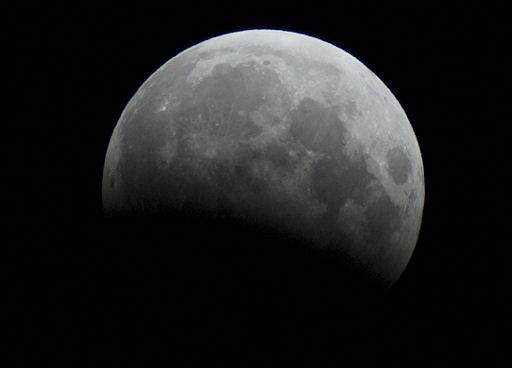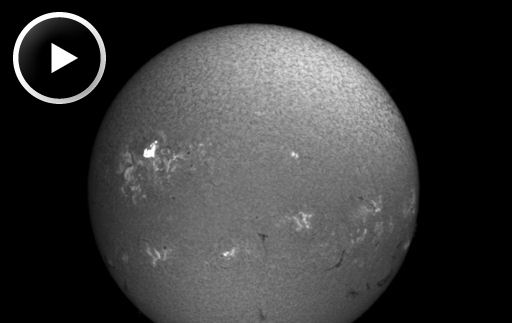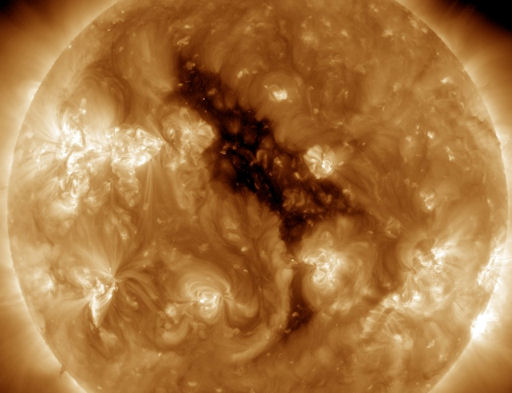THE MYSTERIOUS ARC OF VENUS: Astronomers hope to glimpse a "ring of fire" around Venus during its historic transit across the sun on June 5-6. The apparition, if it is seen, could help crack some of the deepest mysteries of the second planet. Get the full story from Science@NASA.
LUNAR ECLIPSE: This morning, June 4th, the Moon glided through the shadow of Earth, producing a 38% lunar eclipse visible across the Pacific from east Asia to North America. Coyote songs filled the air outside Borrego Springs, California, when Dennis Mammana took this picture of the full Moon cut almost in half:
"The desert night air was cool, the moonlight glorious and the coyotes were yipping away merrily in the distance. What a great night for an eclipse! This shot of mid-eclipse was captured with a University Optics 80mm refractor telescope and a Nikon D700 digital camera."
Browse the real time photo gallery for more moonshots:
Space Weather Real Time Image Gallery
[Submit your photos] [NASA videos: Partial Eclipse of the Strawbery Moon]
Watch the eclipse unfold in SpaceWeather.com's Realtime Photo Gallery.
SOLAR TSUNAMI: New sunspot 1496 unleashed an impulsive M3-class solar flare on June 3rd at 1755 UT. In New Mexico, amateur astronomer Thomas Ashcraft was monitoring the sun when the explosion occurred, and he video-recorded a powerful solar tsunami issuing from the blast site:
"This was a great solar event!" says Ashcraft. "The blast wave sparked powerful radio emissions as it plowed through the sun's atmosphere, and I recorded the sounds using my shortwave radio telescope."
The explosion also hurled a coronal mass ejection (CME) into space: SOHO movie. The cloud does not appear to be heading for Earth, although this conclusion could be revised by further analysis. Stay tuned. Solar Flare alerts: text, voice.
'CH' STANDS FOR ... CHICKEN? A big dark hole in the sun's atmosphere, a 'coronal hole', is turning toward Earth spewing solar wind. According to NASA's official rubber chicken, it looks an awful lot like a bird:
Coronal holes are places where the sun's magnetic field opens up and allows the solar wind to escape. A chicken-shaped stream of solar wind flowing from this coronal hole will reach Earth on June 5th - 7th, possibly stirring geomagnetic storms. High-latitude sky watchers should be alert for auroras. Aurora alerts: text, voice.

![]()
Solar wind
speed: 567.6 km/sec
density: 2.4 protons/cm3
explanation | more data
Updated: Today at 1555 UT
![]()
X-ray Solar Flares
6-hr max: B9 1542 UT Jun04
24-hr: C1 0936 UT Jun04
explanation | more data
Updated: Today at: 1600 UT
![]()
![]()
![]()
Daily Sun: 04 Jun 12
![]()
![]()
Sunspot complex 1493-1496 poses a threat for M-class solar flares. Credit: SDO/HMI
![]()
![]()
![]()
Sunspot number: 133
What is the sunspot number?
Updated 03 Jun 2012
Spotless Days
Current Stretch: 0 days
2012 total: 0 days (0%)
2011 total: 2 days (<1%)
2010 total: 51 days (14%)
2009 total: 260 days (71%)
Since 2004: 821 days
Typical Solar Min: 486 days
Updated 03 Jun 2012
The Radio Sun
10.7 cm flux: 129 sfu
explanation | more data
Updated 03 Jun 2012
![]()
![]()
![]()
Current Auroral Oval:
![]()
Switch to: Europe, USA, New Zealand, Antarctica
Credit: NOAA/POES
![]()
![]()
![]()
Planetary K-index
Now: Kp= 4 unsettled
24-hr max: Kp= 4 unsettled
explanation | more data
![]()
Interplanetary Mag. Field
Btotal: 9.2 nT
Bz: 0.7 nT south
explanation | more data
Updated: Today at 1556 UT
![]()
![]()
![]()
Coronal Holes: 04 Jun 12
![]()
![]()
Solar wind flowing from this chicken-shaped coronal hole should reach Earth on June 5-7. Credit: SDO/AIA.







